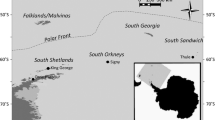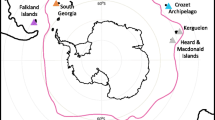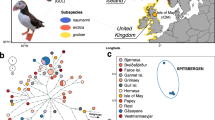Abstract
Information on the extent of genetic differentiation among seabird populations is essential for conservation planning. Here we used, for the first time in little penguins (Eudyptula minor), a next generation sequencing approach to investigate population genetic structure, gene flow and inbreeding among eight colonies in South Australia. We found that Troubridge Island individuals were genetically distinct from the other sampled colonies, and that colonies on all islands were connected by moderate levels of gene flow possibly due to migration from the Kangaroo Island colonies. While further genetic sampling is needed, these data support the idea that South Australia may be a zone of subtle and rapid genetic change for little penguins.



Similar content being viewed by others
Data accessibility
Data are deposited in the Flinders University data repository at https://doi.org/10.25957/5edf2eddcd327.
References
Agnew P, Lalas C, Wright J, Dawson S (2015) Variation in breeding success and survival of little penguins Eudyptula minor in response to environmental variation. Mar Ecol Prog Ser 541:219–229
Akst EP, Boersma PD, Fleischer RC (2002) A comparison of genetic diversity between the Galápagos penguin and the Magellanic penguin. Conserv Genet 3:375–383
Ancel A, Beaulieu M, Gilbert C (2013) The different breeding strategies of penguins: a review. C R Biol 336:1–12
Aubin T, Jouventin P (2002) How to vocally identify kin in a crowd: the penguin model. Adv Study Behav 31:243–277
Baird NA, Etter PD, Atwood TS, Currey MC, Shiver AL, Lewis ZA, Selker EU, Cresko WA, Johnson EA (2008) Rapid SNP discovery and genetic mapping using sequenced RAD markers. PLoS ONE 3:1–7
Bool NM, Page B, Goldsworthy SD (2007) What is causing the decline of little penguins on Granite Island, South Australia? Research Report Series. South Australian Research and Development Institute, Adelaide
Bull L (2000) Fidelity and breeding success of the blue penguin Eudyptula minor on Matiu-Somes Island, Wellington, New Zealand. N Z J Zool 27:291–298
Burridge CP, Peucker AJ, Valautham SK, Styan CA, Dann P (2015) Non-equilibrium conditions explain spatial variability in genetic structuring of little penguin (Eudyptula minor). J Hered 106:228–237
Cannell BL, Krasnec KV, Campbell K, Jones HI, Miller RD, Stephens N (2013) The pathology and pathogenicity of a novel Haemoproteus spp. infection in wild little penguins (Eudyptula minor). Vet Parasitol 197:74–84
Chambers LE, Dann P, Cannell B, Woehler EJ (2014) Climate as a driver of phenological change in southern seabirds. Int J Biometeorol 58:603–612
Charlesworth D, Charlesworth B (1987) Inbreeding depression and its evolutionary consequences. Annu Rev Ecol Evol Syst 18:237–268
Coates DJ, Byrne M, Moritz C (2018) Genetic diversity and conservation units: dealing with the species-population continuum in the age of genomics. Front Ecol Evol 6:165
Colombelli-Négrel D (2015) Low survival rather than breeding success explains little penguin population decline on Granite Island. Mar Fresh Water Res 66:1057–1065
Colombelli-Négrel D (2016) Both natural selection and isolation by distance explain phenotypic divergence in bill size and body mass between South Australian little penguin colonies. Ecol Evol 6:7965–7975
Colombelli-Négrel D (2017) Penguin monitoring and conservation activities in Gulf St Vincent (July 2016–June 2017). Report to Adelaide and Mount Lofty Ranges NRM Board, Adelaide
Colombelli-Négrel D (2019) Penguin monitoring and conservation activities in Gulf St Vincent (July 2018–May 2019). Report to Adelaide and Mount Lofty Ranges NRM Board, Adelaide
Colombelli-Négrel D, Kleindorfer S (2014) Penguin monitoring and conservation activities in Gulf St Vincent (July 2013–June 2014). Report to Adelaide and Mount Lofty Ranges NRM Board, Adelaide
Colombelli-Négrel D, Smale R (2017) Habitat explained microgeographic variation in Little Penguin agonistic calls. Auk 135:44–59
Colombelli-Négrel D, Tomo I (2017) Identification of terrestrial predators at two Little Penguin colonies. Aust Field Ornithol 34:1–9
Coffin HR, Watters JV, Mateo JM (2011) Odor-based recognition of familiar and related conspecifics: a first test conducted on captive Humboldt penguins (Spheniscus humboldti). PLoS ONE 6:e25002
Coulson JC (2001) Colonial breeding in seabirds. In: Schreiber EA, Burger J (eds) Biology of marine birds. CRC Press, Boca Raton, pp 87–113
Crandall KA, Bininda-Emonds OR, Mace GM, Wayne RK (2000) Considering evolutionary processes in conservation biology. Trends Ecol Evol 15:290–295
Croxall JP, Trathan PN, Murphy EJ (2002) Environmental change and Antarctic seabird populations. Science 297:1510–1514
Dann P (2016) Independent report on the risk assessment for little penguins in South Australia including management recommendations and priorities. Report prepared for the Department of Environment, Water and Natural Ressources, Phillip Island, Victoria
Dann P, Chambers L (2013) Ecological effects of climate change on little penguins Eudyptula minor and the potential economic impact on tourism. Clim Res 58:67–79
Department of Environment, Water and Natural Resources (2016) Conservation risk assessment report for little penguins in South Australia. DEWNR technical report 2016/33, Adelaide.
Elshire RJ, Glaubitz JC, Sun Q, Poland JA, Kawamoto K, Buckler ES, Mitchell SE (2011) A robust, simple genotyping-by-sequencing (GBS) approach for high diversity species. PLoS ONE 6:e19379
Evanno G, Regnaut S, Goudet J (2005) Detecting the number of clusters of individuals using the software structure: a simulation study. Mol Ecol 14:2611–2620
Falush D, Stephens M, Pritchard JK (2003) Inference of population structure using multilocus genotype data: linked loci and correlated allele frequencies. Genetics 164:1567–1587
Fischer MC, Rellstab C, Leuzinger M, Roumet M, Gugerli F, Shimizu KK, Holderegger R, Widmer A (2017) Estimating genomic diversity and population differentiation—an empirical comparison of microsatellite and SNP variation in Arabidopsis halleri. BMC Genom 18:69
Foll M, Gaggiotti O (2008) A genome-scan method to identify selected loci appropriate for both dominant and codominant markers: a Bayesian perspective. Genetics 180:977–993
Freer JJ, Mable BK, Clucas G, Rogers AD, Polito MJ, Dunn M, Naveen R, Levy H, Hart T (2015) Limited genetic differentiation among chinstrap penguin (Pygoscelis antarctica) colonies in the Scotia Arc and Western Antarctic Peninsula. Polar Biol 38:1493–1502
Friesen VL, Burg TM, McCoy KD (2007) Mechanisms of population differentiation in seabirds. Mol Ecol 16:1765–1785
Gamfeldt L, Wallén J, Jonsson PR, Berntsson KM, Havenhand JN (2005) Increasing intraspecific diversity enhances settling success in a marine invertebrate. Ecology 86:3219–3224
Ganendran LB, Sidhu LA, Catchpole EA, Chambers LE, Dann P (2016) Effects of ambient air temperature, humidity and rainfall on annual survival of adult little penguins Eudyptula minor in southeastern Australia. Int J Biometeorol 60:1237–1245
Gärke C, Ytournel F, Bed’hom B, Gut I, Lathrop M, Weigend S, Simianer H (2012) Comparison of SNPs and microsatellites for assessing the genetic structure of chicken populations. Anim Genet 43:419–428
Garroway CJ, Radersma R, Sepil I, Santure AW, De Cauwer I, Slate J, Sheldon BC (2013) Fine-scale genetic structure in a wild bird population: the role of limited dispersal and environmentally based selection as causal factors. Evolution 67:3488–3500
Glaubitz JC, Casstevens TM, Lu F, Harriman J, Elshire RJ, Sun Q, Buckler ES (2014) TASSEL-GBS: a high capacity genotyping by sequencing analysis pipeline. PLoS ONE 9:e90346
Goldsworthy SD, Page B, Rogers PJ, Bulman C, Wiebkin A, McLeay LJ, Einoder L, Baylis AMM, Braley M, Caines R, Daly K, Huveneers C, Peters K, Lowther AD, Ward TM (2013) Trophodynamics of the eastern Great Australian Bight ecosystem: ecological change associated with the growth of Australia's largest fishery. Ecol Model 255:38–57
Gruber B, Unmack PJ, Berry OF, Georges A (2018) dartr: an r package to facilitate analysis of SNP data generated from reduced representation genome sequencing. Mol Ecol Res 18:691–699
Hess JE, Matala AP, Narum SR (2011) Comparison of SNPs and microsatellites for fine-scale application of genetic stock identification of Chinook salmon in the Columbia River Basin. Mol Ecol Res 11:137–149
Höglund J (2009) Evolutionary conservation genetics. Oxford University Press, Oxford
Hughes AR, Inouye BD, Johnson MT, Underwood N, Vellend M (2008) Ecological consequences of genetic diversity. Ecol Lett 11:609–623
International Union for Conservation of Nature (2019) The Red List of Threatened Species. https://www.iucnredlist.org/
Jamieson IG, Taylor SS, Tracy LN, Kokko H, Armstrong DP (2009) Why some species of birds do not avoid inbreeding: insights from New Zealand Robins and Saddlebacks. Behav Ecol 20:575–584
Johannesen E, Perriman L, Steen H (2002) The effect of breeding success on nest and colony fidelity in the little penguin (Eudyptula minor) in Otago, New Zealand. Emu 102:241–247
Jombart T (2008) Adegenet: a R package for the multivariate analysis of genetic markers. Bioinformatics 24:1403–1405
Jombart T, Ahmed I (2011) Adegenet 1.3-1: new tools for the analysis of genome-wide SNP data. Bioinformatics 27:3070–3071
Keller LF, Waller DM (2002) Inbreeding effects in wild populations. Trends Ecol Evol 17:230–241
Keller LF, Grant PR, Grant BR, Petren K (2002) Environmental conditions affect the magnitude of inbreeding depression in survival of Darwin's finches. Evolution 56:1229–1239
Kopelman NM, Mayzel J, Jakobsson M, Rosenberg NA, Mayrose I (2015) Clumpak: a program for identifying clustering modes and packaging population structure inferences across K. Mol Ecol Res 15:1179–1191
Lesica P, Allendorf FW (1995) When are peripheral populations valuable for conservation? Conserv Biol 9:753–760
Lischer H, Excoffier L (2012) PGDSpider: an automated data conversion tool for connecting population genetics and genomics programs. Bioinformatics 28:298–299
Lu F, Lipka AE, Glaubitz J, Elshire R, Cherney JH, Casler MD, Buckler ES, Costich DE (2013) Switchgrass genomic diversity, ploidy, and evolution: novel insights from a network-based SNP discovery protocol. PLoS Genet 9:e1003215
Ludwig SC, Becker PH (2012) Immigration prevents inbreeding in a growing colony of a long-lived and philopatric seabird. Ibis 154:74–84
Lynch HJ, Naveen R, Trathan PN, Fagan WF (2012) Spatially integrated assessment reveals widespread changes in penguin populations on the Antarctic Peninsula. Ecology 93:1367–1377
Milligan BG (2003) Maximum-likelihood estimation of relatedness. Genetics 163:1153–1167
Milot E, Weimerskirch H, Bernatchez L (2008) The seabird paradox: dispersal, genetic structure and population dynamics in a highly mobile, but philopatric albatross species. Mol Ecol 17:1658–1673
Moritz C (1994) Defining evolutionary significant units for conservation. Trends Ecol Evol 9:373–375
Mussmann SM, Douglas MR, Chafin TK, Douglas ME (2019) BA3-SNPs: contemporary migration reconfigured in BayesAss for next-generation sequence data. Methods Ecol Evol 10:1808–1813
Nakagawa S, Waas JR, Miyazaki M (2001) Heart rate changes reveal that little blue penguin chicks (Eudyptula minor) can use vocal signatures to discriminate familiar from unfamiliar chicks. Behav Ecol Sociobiol 50:180–188
Oro D, Ruxton GD (2001) The formation and growth of seabird colonies: Audouin’s gull as a case study. J Anim Ecol 70:527–535
Overeem R, Wallis R (2007) Decline in numbers of Little Penguin Eudyptula minor at Middle Island, Warrnambool, Victoria. Vic Nat 124:19–22
Overeem RL, Peucker AJ, Austin CM, Dann P, Burridge CP (2008) Contrasting genetic structuring between colonies of the World’s smallest penguin, Eudyptula minor (Aves: Spheniscidae). Conserv Genet 9:893–905
Peucker AJ, Dann P, Burridge CP (2009) Range-wide phylogeography of the Little Penguin (Eudyptula minor): evidence of long-distance dispersal. Auk 126:397–408
Pledger S, Bullen L (1998) Tests for mate and nest fidelity in birds with application to little blue penguins (Eudyptula minor). Biometrics 54:61–66
Poland JA, Brown PJ, Sorrells ME, Jannink J-L (2012) Development of high-density genetic maps for barley and wheat using a novel two-enzyme genotyping- by-sequencing approach. PLoS ONE 7:e0032253
Porras-Hurtado L, Ruiz Y, Santos C, Phillips C, Carracedo Á, Lareu M (2013) An overview of STRUCTURE: applications, parameter settings, and supporting software. Front Genet 4:98
Pritchard JK, Stephens M, Donnelly P (2000) Inference of population structure using multilocus genotype data. Genetics 155:945–959
R Core Team (2015) R: a language and environment for statistical computing. R Foundation for Statistical Computing, Vienna
Rambaut A, Suchard M, Xie D, Drummond A (2014) Tracer v1.6. https://beast.bio.ed.ac.uk/Tracer.
Reilly P, Cullen J (1981) The little penguin Eudyptula minor in Victoria, II: breeding. Emu 81:1–19
Rice WR (1989) Analyzing tables of statistical tests. Evolution 43:223–225
Rizvanovic M, Kennedy JD, Nogués-Bravo D, Marske KA (2019) Persistence of genetic diversity and phylogeographic structure of three New Zealand forest beetles under climate change. Divers Distrib 25:142–153
Sander M, Balbao TC, Polito MJ, Costa ES, Carneiro APB (2007) Recent decrease in chinstrap penguin (Pygoscelis antarctica) populations at two of Admiralty Bay’s islets on King George Island, South Shetland Islands, Antarctica. Polar Biol 30:659–661
Smith L, Burgoyne L (2004) Collecting, archiving and processing DNA from wildlife samples using FTA® databasing paper. BMC Ecol 4:4
Soulé ME (1987) Viable populations for conservation. Cambridge University Press, Cambridge
Stevenson C, Woehler EJ (2007) Population decreases in little penguins Eudyptula minor in southeastern Tasmania, Australia, over the past 45 years. Mar Ornithol 35:61–66
Tomo I (2012) Pathology of little penguins in May 2011–June 2012, report to Adelaide Mt Lofty Natural Resource Management Board and Kangaroo Island Natural Resource Management Board, Adelaide
Tomo I (2014) Monitoring little penguin mortalities in eastern Gulf St Vincent. July 2013–March 2014, report to Adelaide Mt Lofty Natural Resource Management Board and Kangaroo Island Natural Resource Management Board, Adelaide
Trathan PN, Garcia-Borboroglu P, Boersma D, Bost CA, Crawford RJ, Crossin GT, Cuthbert RJ, Dann P, Davis LS, De La Puente S, Ellenberg U, Lynch HJ, Mattern T, Putz K, Seddon PJ, Trivelpiece W, Wienecke B (2014) Pollution, habitat loss, fishing, and climate change as critical threats to penguins. Conserv Biol 29:31–41
Trivelpiece WZ, Hinke JT, Miller AK, Reiss CS, Trivelpiece SG, Watters GM (2011) Variability in krill biomass links harvesting and climate warming to penguin population changes in Antarctica. PNAS 108:7625–7628
Walther G-R, Post E, Convey P, Menzel A, Parmesan C, Beebee TJ, Fromentin J-M, Hoegh-Guldberg O, Bairlein F (2002) Ecological responses to recent climate change. Nature 416:389–395
Wang J (2011) COANCESTRY: a program for simulating, estimating and analysing relatedness and inbreeding coefficients. Mol Ecol Resour 11:141–145
Wang J (2017) The computer program structure for assigning individuals to populations: easy to use but easier to misuse. Mol Ecol Res 17:981–990
Wiebkin AS (2010) Little penguins at Troubridge Island: establishing a monitoring program for the future. Research Report Series. South Australian Research and Development Institute, Adelaide, pp 1–16
Wiebkin AS (2011) Conservation management priorities for little penguin populations in Gulf St Vincent. Research Report Series. South Australian Research and Development Institute, Adelaide, pp 1–97
Wiebkin AS (2012) Feeding and breeding ecology of little penguins. PhD thesis. University of Adelaide, Adelaide
Williams TD (1995) The penguins. Oxford University Press, Oxford
Wilson GA, Rannala B (2003) Bayesian inference of recent migration rates using multilocus genotypes. Genetics 163:1177–1191
Acknowledgements
We would like to thank the Evolutionary Biology Unit at the South Australian Museum for technical assistance. We thank Tim March for the bioinformatics. For collection of samples, we would like to thank Ikuko Tomo of the SA Museum, Katharina Peters, Anna Koetz, and all the volunteers involved in collecting the data. Special thanks to the Granite Island Penguin Centre manager, Dorothy Longden, for her help in collecting data on the captive penguins at the Granite Island Penguin Centre. We also wish to thank Martine Kinloch, Kym Lashmar and Alicia McArdle for their assistance on Kangaroo Island, and Chris Johnson for access to Troubridge Island. Finally, we thank Tony Flaherty and Sonia Kleindorfer for their continued support.
Funding
The project was funded by the Adelaide and Mt Lofty Natural Resources Management Board and the Nature Conservation Society of South Australia. Permits This project was approved by the Flinders University Ethics Committee (E388) and supported by a scientific permit to conduct the research (Y26040).
Author information
Authors and Affiliations
Corresponding author
Ethics declarations
Conflict of interest
The authors declare no conflicts of interest.
Additional information
Publisher's Note
Springer Nature remains neutral with regard to jurisdictional claims in published maps and institutional affiliations.
Electronic supplementary material
Rights and permissions
About this article
Cite this article
Colombelli-Négrel, D., Slender, A., Bradford, T. et al. Subtle genetic clustering among South Australian colonies of little penguins (Eudyptula minor). Conserv Genet 21, 747–756 (2020). https://doi.org/10.1007/s10592-020-01284-4
Received:
Accepted:
Published:
Issue Date:
DOI: https://doi.org/10.1007/s10592-020-01284-4




